The best turntable
Wirecutter narrowed it down to two picks.
By Chris Heinonen
This post was done in partnership with Wirecutter. When readers choose to buy Wirecutter's independently chosen editorial picks, Wirecutter and Engadget may earn affiliate commission. Read the full guide to turntables.
Whether you're buying your first turntable or returning to the hobby after a long absence, we think you should get the Denon DP-400 because it delivers the best combination of sound quality and user-friendly features. It has a built-in phono preamp for hassle-free setup, offers above-average adjustment flexibility, and sounds great out of the box.
The Denon DP-400 has a very clear and detailed sound, was the most speed-accurate of any turntable we tested, and played with very little distortion. It has an integrated phono preamp, so unlike many higher-end turntables, it doesn't require extra hardware to get started. The DP-400 offers convenient features like a speed control dial and automatic platter stopping with tonearm lift when a record finishes playing. The turntable performs very well with the standard cartridge, but if you attach an upgraded cartridge like a premounted Ortofon Red or Blue, you'll have a system that's so good that you'll never feel the need to upgrade further.
If you're willing to sacrifice some convenient features—like easy speed switching, auto-stop, and a cue lever to raise and lower the tonearm—the U-Turn Orbit Basic offers good sound quality at a great price. The Orbit Basic takes almost no time to set up and is highly customizable. You can order it with a built-in phono preamp, choose a different color, upgrade the cartridge, and even add a cue lever later on. Its simple design works well.
Why you should trust us
I've reviewed audio gear for almost a decade and listened to turntables since the late 1990s. I try to ground all of my conclusions in objective and subjective data from testing as well as the experience gained during the hundreds of hours a year I spend evaluating and comparing audio products.
Who should get this
These entry-level and mid-level turntables are for the person who is getting into vinyl playback for the first time or has been out of it for a while and wants a simple solution for playing their record collection. For this person, we think simplicity and ease-of-use are just as important as overall sound quality. If you're new to turntables, you might want to read the Terminology section below to learn about some of the basic parts and functions we'll be discussing here.
If you want to experience the absolute best in vinyl sound quality, you'll want a separate phono preamp that offers features like variable loading and adjustable resistance so that it will work with a full range of cartridges. You also might want a turntable that lets you replace the tonearm, so you can experiment with different lengths and materials to find the option that sounds the best to you. Turntables that are suited for this type of user cost far more than the models we considered for this guide.
There are plenty of used turntables out there that are great, but those can take some work and care to optimize their playback. If you're a vinyl veteran, that might be for you, but a second-hand turntable is probably not for the first-time turntable owner.
If you already have a turntable that works for you, you probably don't need to upgrade to a new model from this guide. You can probably get more out of your current system by upgrading the cartridge or getting a new phono preamp than you can from buying a whole new turntable.
How we picked and tested

The turntable market continues to grow, and there's no shortage of options—crowdfunded turntables like those from U-Turn compete with models from more established brands like Denon that predate World War I. For this update, we used the following criteria to help us decide which turntables were best suited to our target audience:
Good sound quality: There is far more variation in sound quality between turntables than there is between digital music players. Some have better bass with more detail and separation, and some do better with vocals. Some turntables are more speed-accurate than others. Records will have occasional pops, and some turntables suppress these better than others.
Easy to set up: Models that require you to mount a cartridge, that need a separate stylus gauge, or that require advanced alignment of the cartridge can be hard for a vinyl novice to set up well. The ability to easily upgrade the cartridge to improve sound quality is also a valuable feature.
Included phono preamp: This is a big plus if you're looking for an uncomplicated audio system, although we don't consider it mandatory. The signal from a phono cartridge must be amplified and equalized to be compatible with normal stereo systems or powered speakers. Some entry-level stereo receivers lack phono preamp sections, and soundbars and wireless speakers never had them, so a built-in preamp makes it easier to add the turntable to your existing system without having to purchase any additional equipment.
Easy to use: Convenience features, like easy switching between speeds and a tonearm that automatically returns, become more important the longer you own a turntable. If you aren't listening to your 45 rpm records because changing the speed on the turntable is a pain, or if you have to worry that you'll forget to stop the player and cause extra wear on the needle, you aren't getting enjoyment from it.
Drive method: We considered belt-drive and direct-drive models for this guide and didn't care which method a turntable used. Many enthusiasts are convinced of the superiority of one or the other. The common belief is that the direct-drive method is more speed-accurate because it drives the platter directly, while the belt-drive method better isolates records and cartridges from motor noise and vibration. We found that, in this price range, neither method had a clear advantage. The direct-drive models were usually more speed-accurate but sometimes had more wow and flutter distortion than the belt-drive models. Most higher-end turntables use belt drive; perhaps at those prices, they can improve the speed accuracy to the point where the belt drive is clearly superior.
Using this criteria as my guide, I spent more than a dozen hours researching every turntable under $500 that I could find. I tracked down bench tests from the few sites that do objective testing, and I spent a lot of time using Google Translate to get reviews from Germany and other countries where turntables remain even more popular than in the US.
After all of that research, I selected nine new or updated turntables to bring in to compare with our previous top pick, the Audio-Technica LP120. For models without an integrated phono preamp, I used the Emotiva XPS-1. If a model had an integrated phono preamp, I typically used that because we figure most of you will, too.
I listened to all of the turntables in my dedicated home theater room that measures 11 by 13 by 8 feet. For direct comparison, I played identical copies of an album on multiple turntables using a line-level audio switcher. Due to the different output levels of each included cartridge, I had to adjust the level each time I switched turntables, which meant I couldn't do a blind test. Speed measurements, along with wow and flutter tests, were performed using the Platter Speed app from Feickert Labs.
Our pick: Denon DP-400
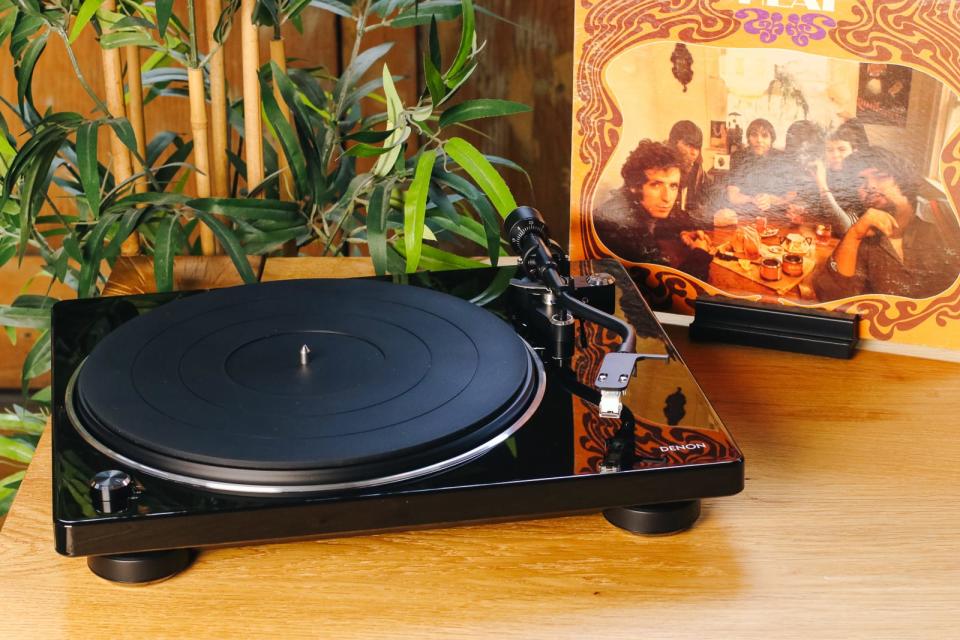
Of all the turntables we tested, the Denon DP-400 offered the best combination of sound quality, ease of use, and convenient features—including a built-in phono preamp, a speed control dial, a cue lever, and automatic platter stopping with tonearm lift. Plus, it's easy to upgrade the cartridge to get even better performance.
The DP-400's sound quality is very good. Background noise ranged from very quiet to almost inaudible, and this model did a good job suppressing pops and other issues in records that some turntables had problems with.
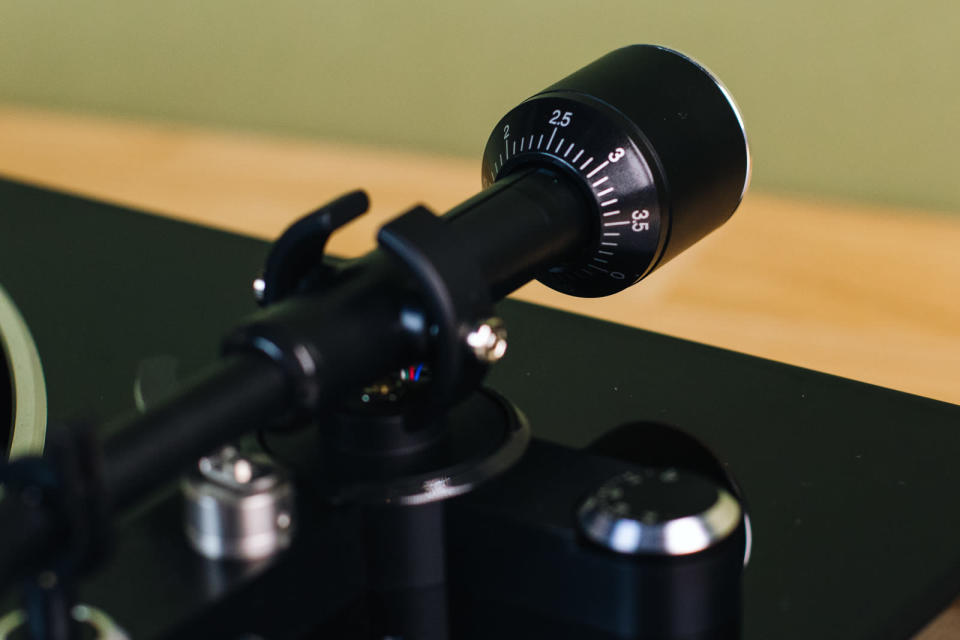
As much as I enjoy listening to vinyl, hearing fewer pops and crackles is always a good thing. Some of the other turntables offered slightly better bass detail, but that was due to the cartridge that came preinstalled. When I replaced the Denon DP-400's stock cartridge with an Ortofon Red or Blue, it sounded as good as or better than any of the other turntables we tested.
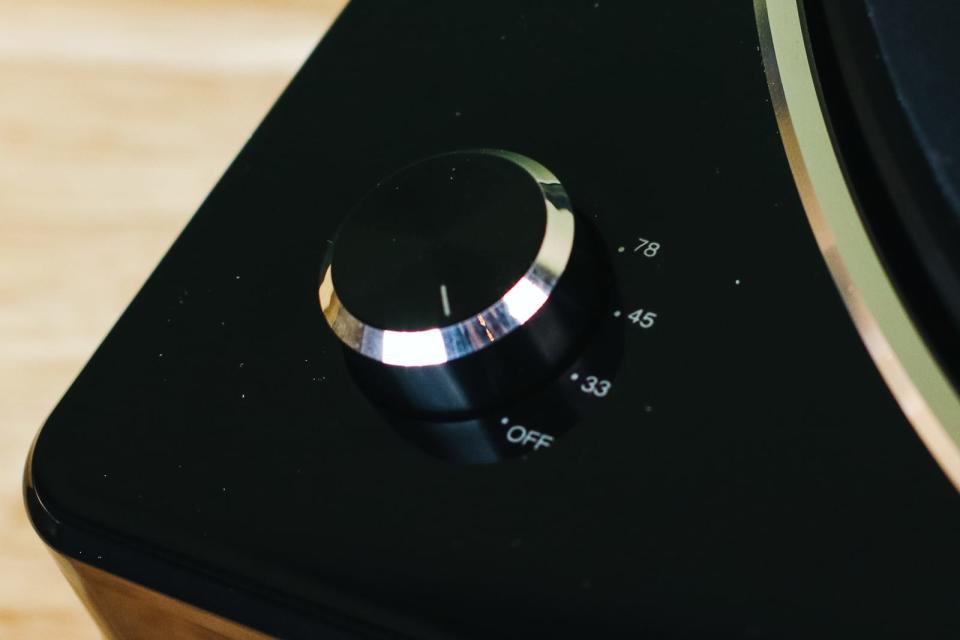
Measuring the performance using the Platter Speed app, I found the belt-drive Denon DP-400 to be the most speed-accurate of all the turntables we tested at both 33 rpm and 45 rpm speeds. In tests, it had a bit more wow and flutter than some competitors, but that's not something that I heard when listening.
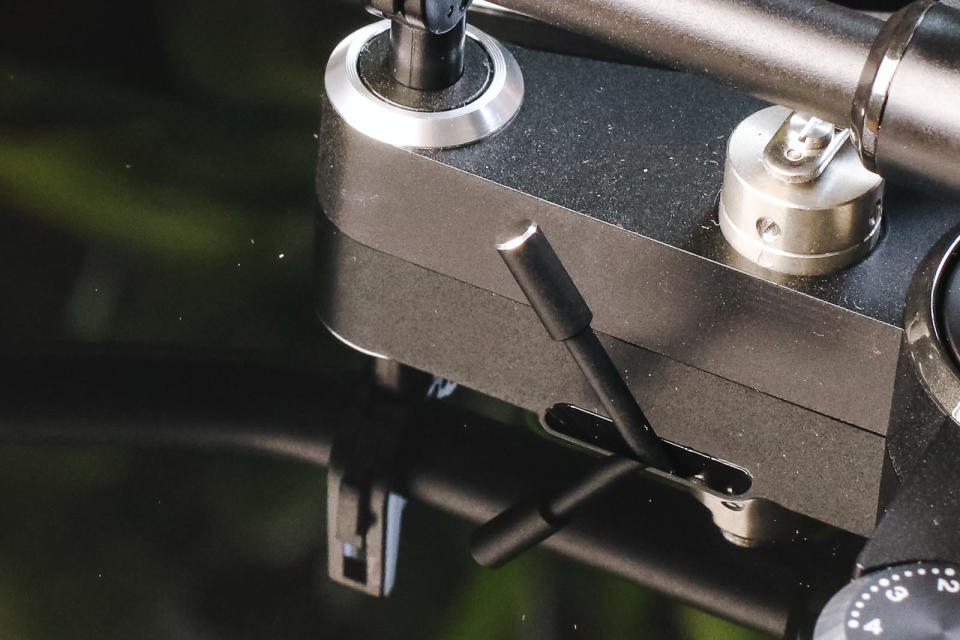
Aside from the fully automatic turntables we tested, the Denon DP-400 was the easiest to use. Balancing the tonearm is simple, and speed selection is done with a dial, so playing back 33, 45, or even 78 rpm records doesn't require lifting up the platter (as you must on some of the other turntables we tested). The included auto-stop function stops your record when you get to the end of a side and lifts up the turntable arm. This saves wear and tear on your stylus needle, which might only be rated for 300 to 400 hours of use, and lets you enjoy playing a record while you do other things without worrying that you aren't there to stop it.
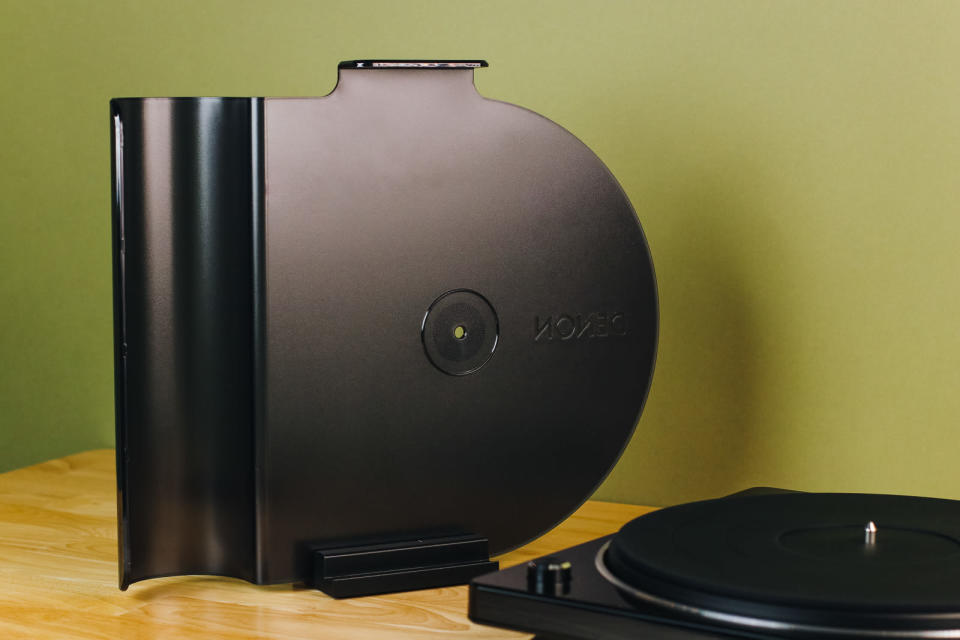
The integrated phono preamp performed well and is easy to disable if you'd prefer to use an external phono preamp. Unlike some of the other turntables we looked at, the Denon uses standard RCA phono jacks instead of an integrated cable, so you can select a cable of the appropriate length. Using an external phono preamp worked well, and this turntable includes a grounding wire connection that some others lacked to help eliminate any ground hum that could occur.
The DP-400 is also an attractive turntable. Finished in a gloss black, it lacks the cheaper, plastic feel of some other models, and it includes a stylish cover that does double-duty as a record presentation stand.
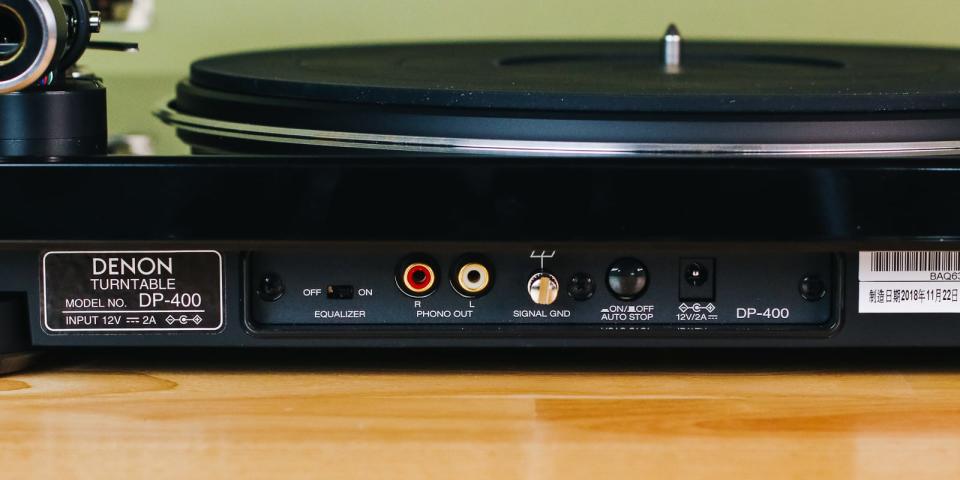
It's easy to upgrade the DP-400 to a higher-quality cartridge down the road. With some of the turntables we tested, you are limited to using the company's own cartridges. Others lack a counterweight that you can adjust to account for a new cartridge. The Denon accepts a standard SH-4 headshell, so it's simple to install a pre-mounted Ortofon Red or Blue cartridge with no tiny screws. I upgraded to an Ortofon Blue, and the resulting sound was so good that I see no reason to ever upgrade past that.
If you want to digitize your record collection to save to a computer or hard drive, Denon offers the DP-450USB, which is otherwise identical to the DP-400 but adds a USB output for an additional $100. This is an easy way to make digital copies of your favorite albums but not as easy as just streaming those titles from a music service (although the sound quality may not be the same and certain records might not be available to stream).
Flaws but not dealbreakers
The DP-400's turntable cover drew mixed reactions: While we liked the look, we missed the ability to put the cover down while listening to a record to keep dust out.
Budget pick: U-Turn Orbit Basic

If you just want to dip your toes into vinyl playback or you don't want to spend very much on a turntable you might not use often, the U-Turn Orbit Basic is a great option. Even if you've never used a turntable before, the Orbit Basic is so easy to set up that you can be listening to records in under 10 minutes. This turntable lacks many of the features that you get with the Denon DP-400, such as a cue lever, easy speed switching, and auto-stop. Still, with good sound quality and lots of customization options (including the ability to order it with a built-in phono preamp for an extra $70), the Orbit Basic is a great way to get started in vinyl.
We listened to a standard unit with the built-in phono preamp, and the sound quality was very good. It sounded much better than the other similarly priced turntables we tested, with better noise rejection and a wider stereo image. Switching between 33 rpm and 45 rpm records does require moving a belt, but that process was easier with this turntable than it is with models that hide the belt underneath the platter. When I first installed the platter and belt, they weren't aligned well, and the platter was wobbly as a result. But installing it again fixed the issue, and the wobbling never happened after that.
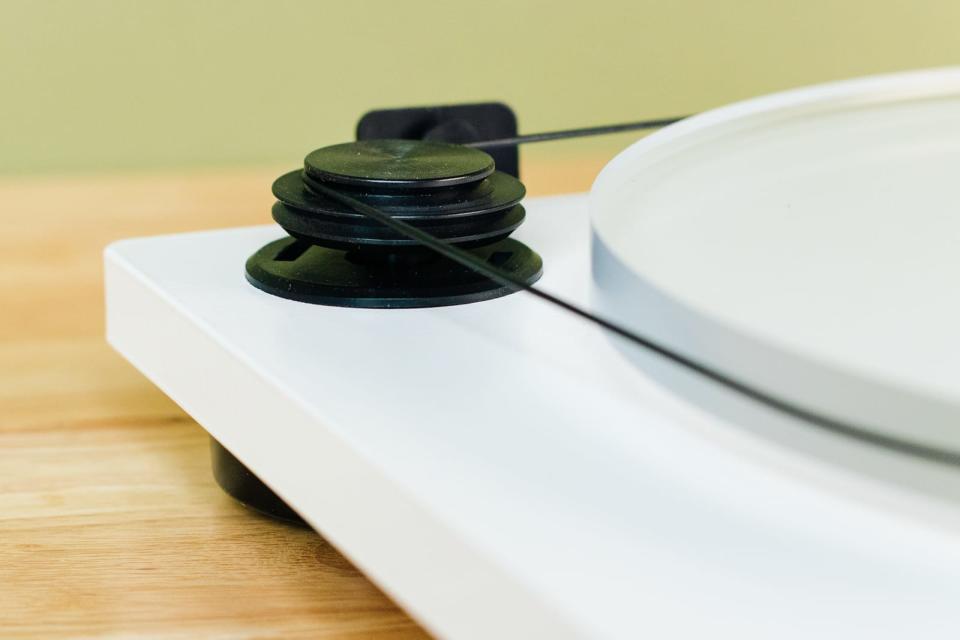
U-Turn makes it easy to customize your turntable. In addition to adding the built-in phono preamp, you can upgrade the cartridge, customize the color of the plinth (or upgrade to a wood veneer), replace the standard MDF platter with a more solid acrylic one, and add a cue lever to easily raise and lower the tonearm. Adding on the phono preamp and changing the plinth color must be done when ordered, but the other upgrades can be done later.

However, with the Orbit Basic, it isn't quite as easy to make certain upgrades as it is with the Denon DP-400. The counterweight of the tonearm lacks the easy adjustment markings that the Denon has, so adding a new cartridge would require a scale and a lot of trial and error. If you don't plan to go down the turntable-upgrade rabbit hole, this won't matter to you.
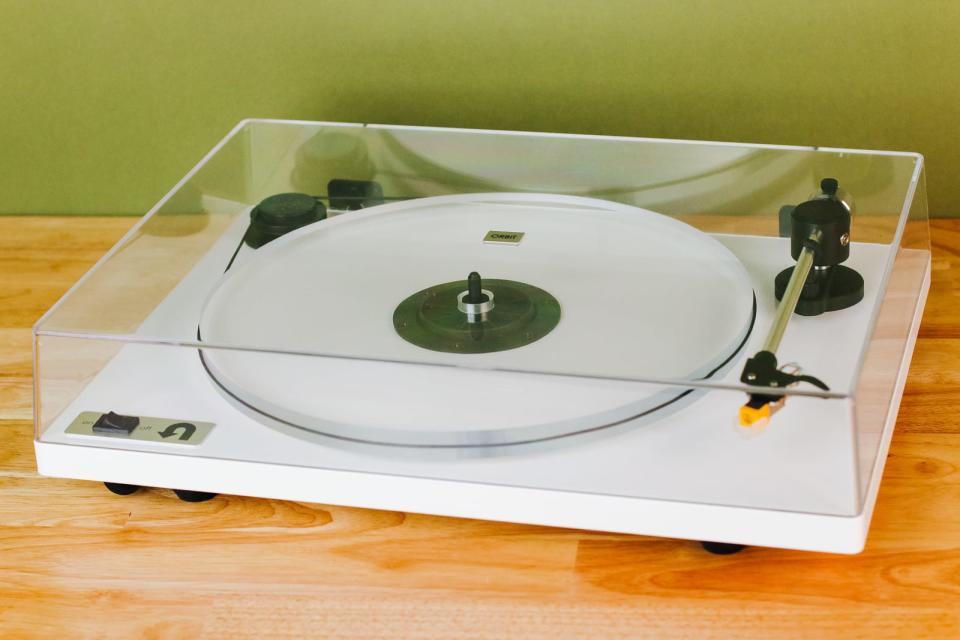
If you've read previous versions of this guide, you might remember that we tested U-Turn turntables back in 2015 when the company first launched and we had lots of issues with the speed accuracy, even after testing four different models and replacement motors. In the four years since then, U-Turn has moved to a new production space, and we have not seen complaints about speed accuracy in professional reviews, Amazon reviews, or user reviews on Reddit and other sources. We tested the Orbit Basic and the Orbit Special for this update, and the speed accuracy was good on both (with 0.10 to 0.13 percent error, while some other tables measured three times worse than that), so we believe the prior issues were related to early production problems and have been ironed out. We will keep an eye on this, but we feel the current track record indicates good reliability.
What to look forward to
We scoped out the latest turntable models at the CES 2019 trade show back in January, and here's what we found most exciting:
Audio Technica revamped its whole line with updated versions of the LP60 and LP120 that feature updated motors but keep the prices the same. The company also introduced two new models, the $300 LPW40WN and the $250 LPW30TK. Both feature MDF platters with wood veneers and are belt-driven instead of direct-driven, with the 40-series model offering an improved motor, upgraded cartridge, and carbon fiber tonearm. We will look to test the updated models and the new 40-series model once they are available.
Technics introduced the new SL-1200 MK7, which builds on the company's popular 1200 turntable line. Gizmodo reports that the MK7 will add even more DJ-friendly features, such as a coreless direct-drive motor intended to prevent the cogging effect common in slow rotation motors, the ability to play in reverse, and adjustable torque options. Price and release date are still unknown, but we'll update this guide when we learn more.
Technics also showed the new SL-1500C turntable with an integrated phono preamp. It's a direct-drive model like the company's 1200 series but removes the DJ features and includes an Ortofon 2M Red cartridge. It has an expected release date in mid-2019, but the estimated price of $1,400 means we are unlikely to test it.
Sony introduced the new LX310BT turntable that includes Bluetooth output, USB output, and an integrated phono stage with adjustable gain. It should be available this spring for $200.
Pro-ject showed off new models to replace its Xpression and Xperience lines at the Bristol Hi-Fi show in 2019. The new models range from £230 to £1,200 and come out later this year, but more details aren't fully known yet.
Terminology
Before you buy or use a new turntable, it helps to be familiar with the jargon. We explain some key terms below.
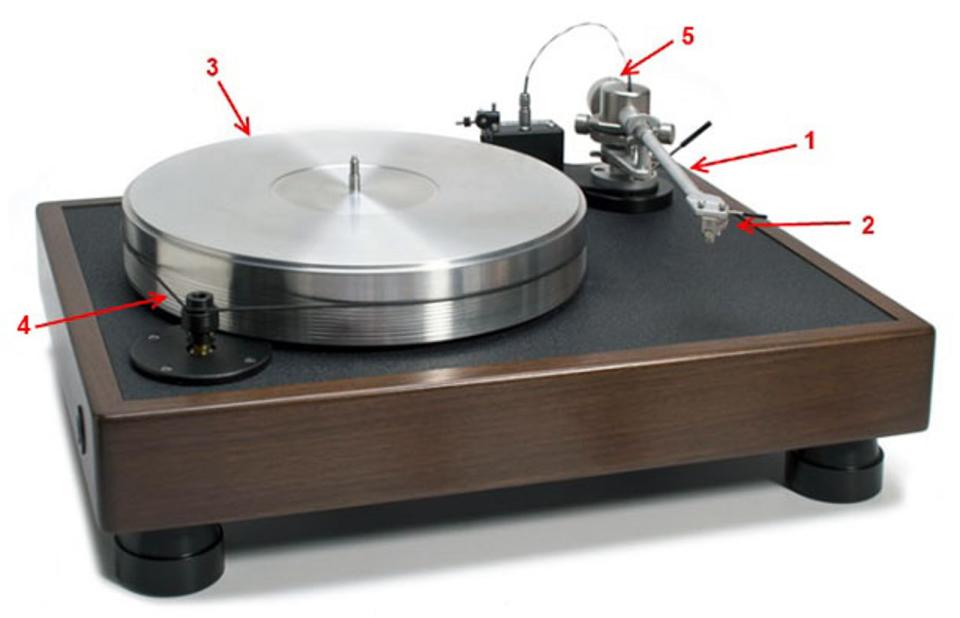
1. Tonearm: The tonearm holds the cartridge as it moves across the record. Typically a tonearm is straight, but some are S-shaped. The ideal tonearm has no mass, is perfectly rigid, and has a bearing with no friction. Because that isn't possible, you want a tonearm that's as light and rigid as you can get. If the tonearm is flimsy and resonates, that resonance will make it into the music. Carbon fiber and other composites are light and stiff, while cheaper metals like aluminum are light but have much more resonance.
2. Cartridge: The cartridge and its stylus are what physically play the record. The stylus moves up and down, left and right, producing a waveform for both stereo channels. There are many types of cartridges, but almost all entry-level turntables will use moving magnet (MM) designs.
3. Platter: Also called a plinth, this is what the record sits on. The platter is rotated by either a direct-drive or belt-drive system (see below). The platter should be as dense as possible to reduce rumble and other mechanical noises that will otherwise make it into the music.
4. Drive method: The platter is either belt-driven or direct-driven. In a belt-drive turntable like the one in our photo example, an elastic belt connects the motor to the platter. The belt's elasticity helps isolate the record and stylus from the motor's vibration and can help reduce wow and flutter, which are speed fluctuations. On higher-end tables, you even see the motor totally isolated from the chassis, which in theory should remove any chance of motor rumble coming through the stylus. Direct-drive turntables have the motor directly connected to the platter. This will pass along far more motor noise, although the effect can be reduced through the use of various platter substances and construction techniques. The benefit of direct drive is that the platter gets up to speed faster and the direct connection provides far more torque, which is why you'll find direct drive in DJ turntables that require speedier response.
5. Tracking force: Cartridges are designed to apply a specific amount of force to a record, specified in grams. Apply too little, and the cartridge and arm will bounce around, skipping constantly. Apply too much, and you'll cause excessive wear of the stylus and the record itself. This is adjusted at the end of the tonearm opposite the cartridge.
Phono stage/phono preamp: The signal from a turntable is far less powerful than the signal from a CD player or other typical audio source. It also requires an equalization function, called the RIAA curve, to achieve a correct balance of bass to treble. A phono stage (or phono preamp) will boost the signal and apply the RIAA curve. Some receivers and integrated amps have built-in phono stages, with an input labeled "Phono" and usually with a ground screw for the turntable's ground cable. If neither your stereo system nor your turntable incorporates a phono preamp, you'll need to buy an external one.
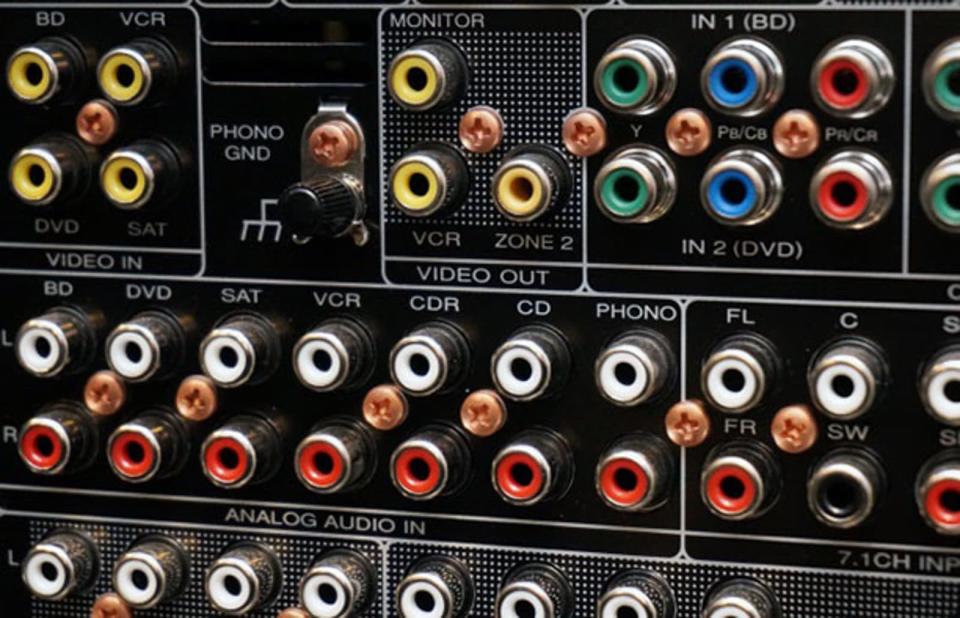
Azimuth adjustment: The stylus on the cartridge should be directly perpendicular to the record itself. The azimuth adjustment lets you rotate the tonearm slightly in each direction to make sure it is correct.
Vertical tracking angle: The body of the cartridge and tip of the stylus should be directly parallel to the record surface while playing. Because records are different thicknesses and cartridges have slightly different sizes, many tonearms offer a way to adjust this.
Care and maintenance
Setting up your turntable correctly is key to getting the best performance out of it. There are many online guides available, including a nice step-by-step one put together by Brent Butterworth for Sound & Vision. There are also lots of video guides on YouTube; some are for specific models that you might buy.
An easy way to improve the quality of your turntable's sound is by upgrading the cartridge. The Ortofon 2M line is very popular, and the best-sounding turntables we've heard use the Red or Blue cartridges. A pre-mounted version is easy to install on our main pick in under 10 minutes, and it made noticeable improvements in bass definition and quality.
Keeping your records in good shape is important. No matter what you spend on a turntable, it sounds only as good as the record does. All the turntable experts I've talked to agree that, when buying your turntable, you should also buy a Spin-Clean. For $80, there's no more cost-effective way to clean vinyl. It requires a bit more manual labor than a vacuum-based record cleaning machine does, but it costs hundreds of dollars less.
Most turntables ship with the cartridge installed and aligned (and include a tool to align it if it is off). If you choose to replace the cartridge, you'll need to align it again. This can be done with a tool like the Mobile Fidelity Geo-Disc or a free protractor you can download and print yourself.
The competition
We tested the following turntables for this update:
The U-Turn Orbit Special offers very attractive wood finishes and comes with an Ortofon Red cartridge, an upgraded platter, and a cue lever. It produced some of the best sound in our testing, but it isn't as easy to use as the Denon DP-400, and the sound-quality differences were very small. Still, the Premium is the best-looking and one of the best-sounding turntables we tested.
The Audio-Technica LP120 was our pick for many years, but it is much larger than our new picks, has many features that you don't need in non-DJ use, and didn't sound as good as our new choices.
The Audio-Technica LP3 is fully automatic with start and stop buttons, but it was one of the least accurate turntables we tested. Also, some reviews indicate possible issues with the motor over long-term use, causing the speed to become unreliable.
The Fluance RT82 and RT85 turntables are easy to set up, feel well built, and include nice features like a bubble level and easy adjustable feet that other companies should emulate. But they had a loud background hum no matter what we tried; other turntables using the same preamp had much lower levels of background noise. The RT85 with an Ortofon Blue cartridge offered the best bass retrieval and definition in our test.
The Rega Planar P1 is easy to set up, and we like the sound, but it isn't as easy to use as other models, with the speed-change belt located under the platter. It also ran about 1 percent fast when we measured it, while our picks were 0.04 to 0.10 percent off.
For previous revisions of this guide, we also tested the following turntables:
The Crosley C200 feels like a very lightweight, cheaper version of the Audio-Technica LP120. It lacks a few of the features of the Audio-Technica, including USB output, and its cartridge isn't as good.
The Crosley C10 sounds and looks good, but in our opinion it's priced too high compared to the Pro-ject Debut Carbon that has a better tonearm and cartridge.
The Music Hall MMF-2.2 bears a lot of similarities to the Pro-ject Carbon. In fact, they come from the same factory. But the MMF-2.2 comes with what most feel is an inferior tonearm and cartridge.
In previous versions of this guide, our upgrade picks were the Pro-ject Debut Carbon and Debut Carbon DC. These turntables sound good, but the Denon is much easier to set up, as is the Rega Planar P1, and both sound just as good.
The Pro-ject Primary sounds good for its price, and the speed change is easy to do, but it has the second-worst wow and flutter measurement in our testing and no phono preamp.
The Pro-ject Elemental line is the company's most affordable, but online reviews show a large number of complaints about the speed accuracy, so we left it out of our testing.
The Pro-ject Essential II falls in between the Primary and the Carbon. It has a more flexible tonearm than the Primary while using the same cartridge, but it doesn't offer the carbon fiber arm or Ortofon Red cartridge of the Carbon. It also has the annoying counterweight that the Primary does not, so we decided to test the Primary instead.
Pro-ject also makes the RM series, which includes the RM-1.3 that reviewers loved when it was released back in 2010. But nowadays it lacks the value that the Carbon provides and is more finicky to use.
Sony's PS-HX500 turntable is the only turntable we know of that can record your records to a PC as DSD, Sony's preferred high-resolution audio format. Unfortunately, it had the worst speed accuracy of any turntable we tested despite its high price, playing 33 rpm records almost 2 percent too fast and 45 rpm records 1.5 percent too fast. Although some of the other turntables were around 0.5 percent fast, that small inaccuracy wasn't noticeable to us. The 2 percent on the Sony was pretty easy to hear.
This guide may have been updated by Wirecutter. To see the current recommendation, please go here.
When readers choose to buy Wirecutter's independently chosen editorial picks, Wirecutter and Engadget may earn affiliate commissions.
